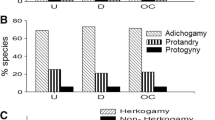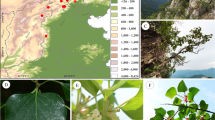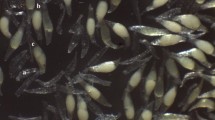Summary
Reports suggest that there is widespread reproductive failure inLinnaea borealis in Britain, Scandinavia, and North America. Our investigations of Scottish populations of this clonal dwarf shrub indicate that, although visited by a number of different insects, pollen transfer in this species is highly effective and principally occurs by small flies (Muscidae). However, natural levels of fruit set varied between populations (from 0% to 25.1%) and reproductive failure was most severe in populations which were composed of single clones. Microscopic examination of stigmas showed that there is no barrier to pollen flow since at least 85% of stigmas have sufficient germinating pollen to effect seed set. Fluorescence microscopy of germinating pollen grains indicates high levels of pollen rejection in the style and only a small proportion of the pollen tubes were able to reach the ovary. It was concluded that lack of xenogamous pollination limits fruit formation in populations ofL. borealis. Reproductive success in an isolated population with extreme reproductive failure was restored by experimental field pollination with viable pollen imported from plants from another population. In Scotland,L. borealis occurs in small, isolated populations and restoration of reproduction can be achieved by the reintroduction of compatible mating partners. This is an important consideration for the conservation management of isolated populations since their long-term recovery may only be possible by translocation of different genotypes from elsewhere into the population. Habitat fragmentation in any part of the species range may impose a potential reproductive bottleneck by causing loss of population diversity and this could explain the low levels of seed set recorded for this species in other parts of its range.
Similar content being viewed by others
References
Angevine MW (1983) Variations in the demography of natural populations of the wild strawberriesFragaria vesca andF. virginiana. J Ecol 71: 959–974
Antos JA, Zobel DB (1984) Ecological implications of belowground morphology of nine coniferous forest herbs. Bot Gaz 145: 508–517
Baker HG, Baker I (1979) Starch in angiosperm pollen grains and its evolutionary significance. Am J Bot 66: 591–600
Barrett SCH, Helenurm K (1987a) The reproductive biology of boreal forest herbs I: breeding systems and pollination. Can J Bot 65: 2036–2046
— —, (1987b) The reproductive biology of boreal forest herbs II: phenology of flowering and fruiting. Can J Bot 65: 2047–2056
Bierzychudek P (1980) Pollinator limitation of plant reproductive effort. Am Nat 117: 838–842
—, (1982) The demography of jack-in-the-pulpit: a forest perrenial that changes sex. Ecol Monogr 52: 335–351
Bawa KS, Webb CJ (1984) Flower fruit and seed abortion in tropical forest trees: implications for the evolution of paternal and maternal reproductive patterns. Am J Bot 71: 736–751
Callaghan TV, Carlsson BA, Johnsdottir IS, Svensson BM, Jonasson S (1992) Clonal plants and environmental change: introduction to the proceedings and summary. Oikos 63: 341–347
Calvo R (1993) Orchid pollination intensity and frequency and the cost of fruiting. Ecology 74: 1033–1042
Clapham AR, Tutin TG, Warburg EF (1962) Flora of the British Isles, 2nd edn. Cambridge University Press, Cambridge
Dafni A (1990) Pollination ecology: a practical approach. Oxford University Press, Oxford
Ericson L (1977) The influence of voles and lemmings on the vegetation in a coniferous forest during a 4-year period in northern Sweden. Walhenbergia 4: 1–114
Eriksson O (1988) Variation in growth rate in shoot populations of the clonal dwarf shrubLinnaea borealis. Holarctic Ecol 11: 259–266
—, (1989) Seedling dynamics and life histories in clonal plants. Oikos 55: 231–238
—, (1992a) Evolution of seed dispersal and recruitment in clonal plants. Oikos 63: 439–448
—, (1992b) Population structure and dynamics of the clonal dwarf shrubLinnaea borealis. J Veg Sci 3: 61–68
—, (1994) Stochastic population dynamics of clonal plants: numerical experiments with ramet and genet models. Ecol Res 9: 257–268
Faegri K, Van der Pijl L (1979) The principles of pollination ecology, 3rd edn. Pergamon Press, Oxford
Garwood NC, Horvitz CC (1985) Factors limiting fruit and seed production of a temperate shrubStaphylea trifolia L. (Staphyieaceae). Am J Bot 72: 453–466
Grime PJ (1979) Plant strategies and vegetation processes. Wiley, Chichester
Hagerup O (1915) CaprifoliaceaeLinnaea borealis L. In: Warming E (ed) The structure and biology of arctic flowering plants II, Meddeleser om Gronland. Copenhagen, pp 151–164
Heslop-Harrison J (1975) Incompatibility and the pollen-stigma interaction. Annu Rev Plant Physiol 26: 403–425
Hiirsalmi H (1969)Trientalis europaea L.: a study of the reproductive biology ecology and variation in Finland. Ann Bot Fenn 6: 173–1969
Hulten E (1968) Flora of Alaska and neighbouring territories: a manual of the vascular plants. Stanford University Press, Stanford, Calif
Jackson AK (ed) (1939) British flowering plants. Ward Lock & Co Ltd, London
Janzen DH, Devries P, Gladstone DE, Higgins ML, Lewinsohn TM (1980) Self- and cross-pollination ofEncyclia cordigera (Orchidaceae) in Santa Rosa National Park. Biotropica 12: 72–74
Kerner A, Oliver FW (1895) The natural history of plants. Blackie & Son, London
Kornas J (1972) Corresponding taxa and their ecological background in the forests of temperate Eurasia and North America. In: Valentine DH (ed) Taxonomy, phytogeography and evolution. Academic Press, London, pp 37–59
Knuth P (1908) Handbook of flower pollination, vol 2. Clarendon Press, Oxford
Laverty TM, Plowright RC (1988) Fruit and seed set in mayapple (Podophyllum peltatum): influence of intraspecific factors and local enhancement nearPedicularis canadensis. Can J Bot 66: 173–178
Lovett Doust J, Lovett Doust L (1988) Sociobiology in plants: an emerging synthesis. In: Lovett Doust J, Lovett Doust L (eds) Plant reproductive ecology. Oxford University Press, Oxford, pp 5–29
Lynham TJ, Wickware GM, Mason JA (1998) Soil chemical change and plant succession following experimental burning in immature jack pine. Can J Bot 78: 93–104
Maciejewska I (1997) Pollen morphology of the Polish species of the family Caprifoliaceae, part 2. Acta Soc Bot Pol 66: 143–151
Marshall DL (1989) Integration of response to defoliation within plants of two species ofSesbania. Funct Ecol 3: 207–214
Neiland MRM, Wilcock CC (1994) Reproductive ecology of European orchids In: Pridgeon A (ed) Proceedings of the 14th World Orchid Conference. HMSO, Edinburgh, pp 138–147
— — (1997) Reproductive ecology and conservation of rare plant species in Scotland. Bot Soc Scotl News 68: 18–19
Nettancourt D de (1977) Incompatibility in angiosperms. Springer, Berlin Heidelberg New York
Perring FH, Walters SM (eds) (1976) Atlas of the British flora. EP Publishers, London
Pignatti S (1982) Flora d'Italia, vol 2. Edagricole, Bologna
Polunin N (1959) Circumpolar arctic flora. Oxford University Press, Oxford
Price AC, Hutchings MJ (1992) The causes and developmental effects of integration and independance between different parts ofGlechoma hederacea clones. Oikos 63: 376–386
Richards AJ (1986) Plant breeding systems. George Alien & Unwin Ltd, London
Ross MS, La Roi GH (1990) Above ground biomass allocation by four understorey vascular plants species in central Alberta jack pinePinus banksiana forests. Can Field Nat 104: 394–402
Roubik DW, Ackerman JD, Copohaver C, Smith BH (1982) Stratum tree and flower selection by tropical bees: implications for the reproductive biology of outcrossingCochlospermum vitifolia in Panama. Ecology 63: 712–720
Snow AA (1986) Pollination dynamics inEpilobium canum (Onagraceae): consequences for gametophytic selection. Am J Bot 73: 139–151
Stace C (1991) New flora of the British Isles. Press Syndicate of the University of Cambridge, Cambridge
Stephenson AG (1981) Flower and fruit abortion: proximate causes and ultimate functions. Annu Rev Ecol Syst 12: 253–279
Swanson SD, Sohmer SH (1976) The biology ofPodophyllum peltatum L. (Berberidaceae), the may apple II: the transfer of pollen and success of sexual reproduction. Bull Torr Bot Club 103: 223–226
Tammisola J (1982) Fruit set and equivalence classes of incompatibility in natural populations of arctic bramble (Rubus arcticus L.) in Finland. Hereditas 97: 331
Tsaryk IV, Malynovs'kyi KA (1995) Disintegration ofLinnaea borealis L. population in stress situation. Ukr Bot Z 52: 379–383
Vanhamajamaa I, Lahde E (1991) Vegetation changes in a burned area planted byPinus sylvestris in Northern Finland. Ann Bot Fenn 28: 161–170
Watson MA, Casper BB (1984) Morphogenic constraints on patterns of carbon distribution in plants. Annu Rev Ecol Syst 15: 233–258
Widen B, Widen M (1990) Pollen limitation and distancedependant fecundity of the clonal gynodioecious herbGlechoma hederacea (Lamiaceae). Oecologia 83: 191–196
Widen M (1992) Sexual reproduction in a clonal gynodioecious herbGlechoma hederacea. Oikos 63: 430–438
Wilcock CC (1990) Botanical sanctuaries for Scotland's threatened flora: symposium on Scotland's Threatened Flora. Trans Bot Soc Edin 45: 509–517
- Neiland MRM (1999) Reproductive characters as priority indicators for rare plant conservation. In: Synge A, Akeroyd J (eds) Planta Europa Proceedings of the second European conference on the conservation of wild plants. Swedish Threatened Species Unit and Plantlife
Wittrock VB (1907)Linnaea borealis L. en mangformig art. Acta Horti Bergiani 7: 5–185
Author information
Authors and Affiliations
Rights and permissions
About this article
Cite this article
Wilcock, C.C., Jennings, S.B. Partner limitation and restoration of sexual reproduction in the clonal dwarf shrubLinnaea borealis L. (Caprifoliaceae). Protoplasma 208, 76–86 (1999). https://doi.org/10.1007/BF01279077
Received:
Accepted:
Issue Date:
DOI: https://doi.org/10.1007/BF01279077




